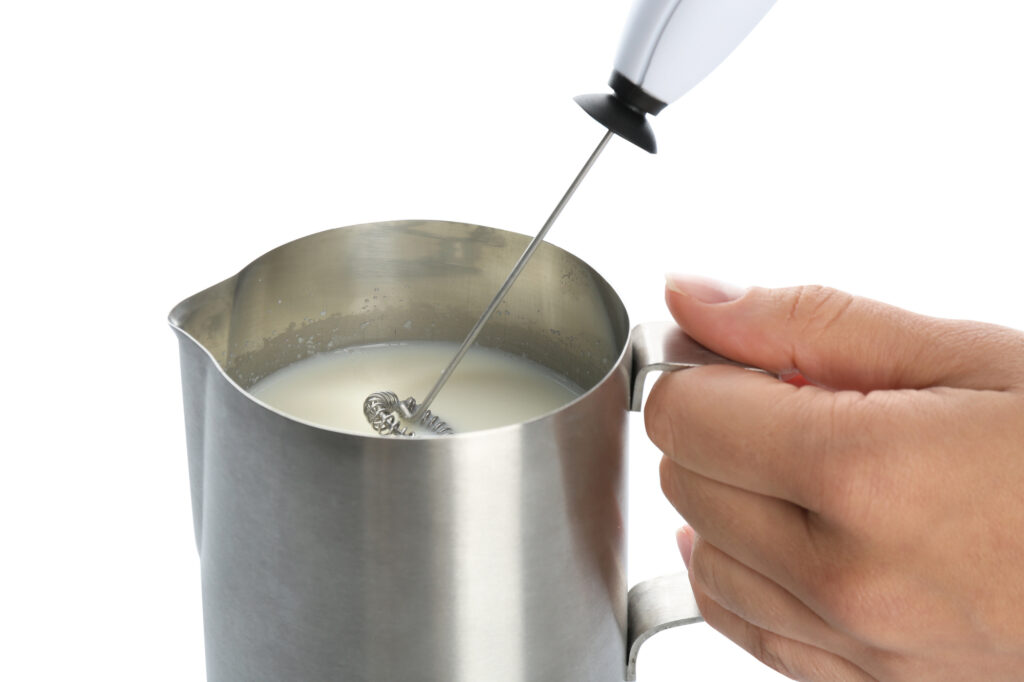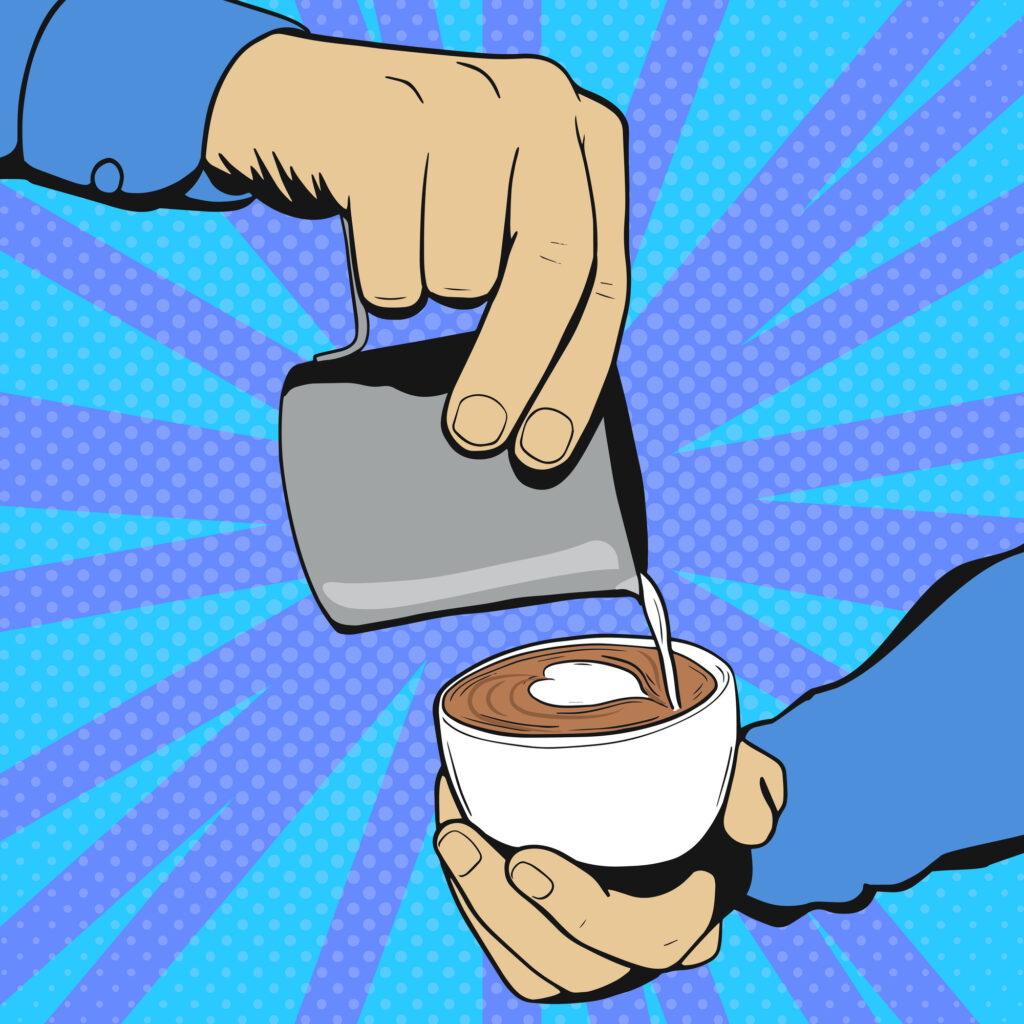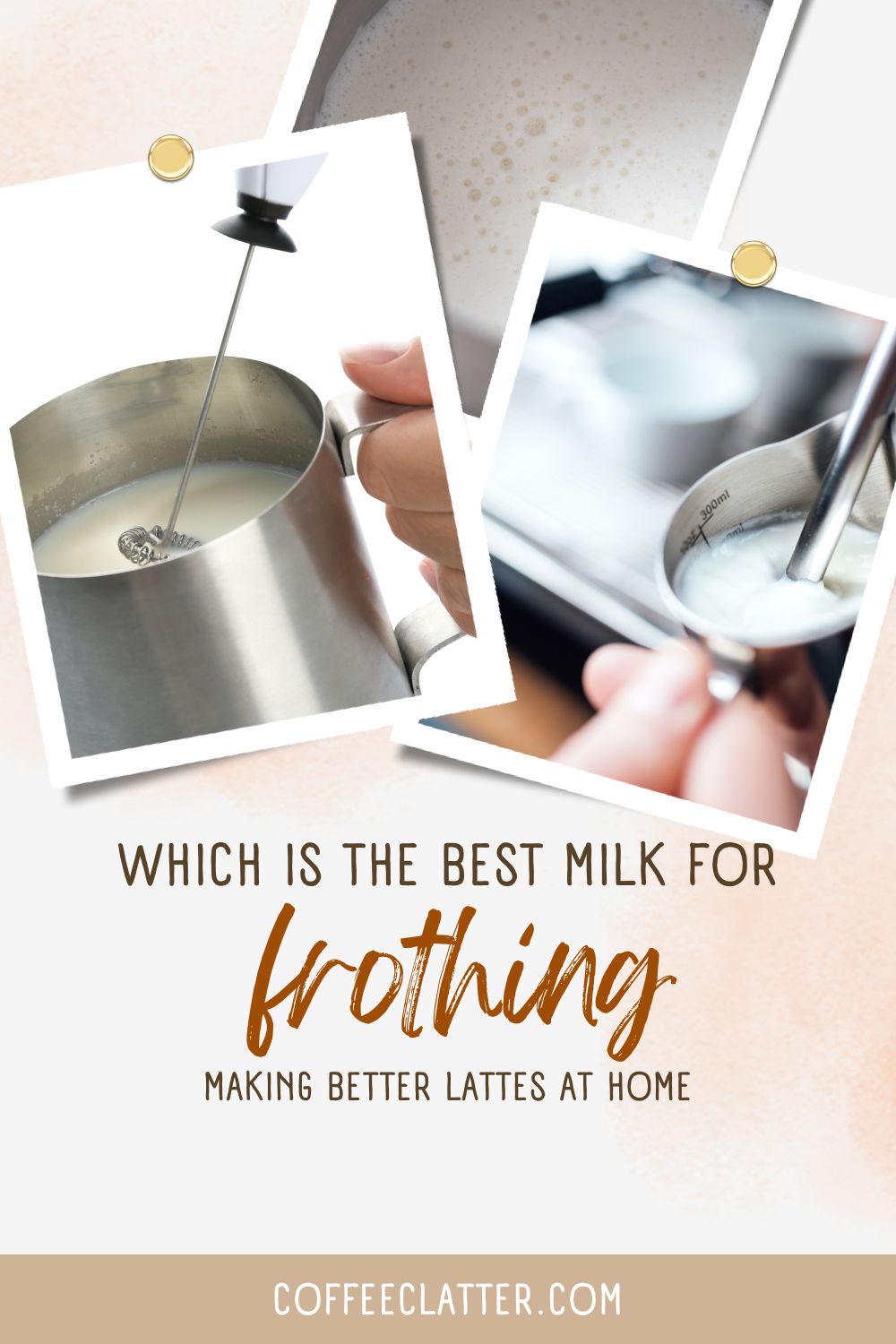How to choose the best milk for frothing?
Let’s face it, milk and coffee are a perfect mixture. Just like chocolate and coffee, liqueurs and coffee, whipped cream and coffee…you get the picture. Coffee goes great with everything. But milk holds a special place in our hearts. You guessed it, we are fans of cappuccino, cafe latte, cortado, and every other coffee drink that involves milk. The main question today is how to choose the perfect milk for frothing? Nowadays, we have too many choices in our hands, from oat milk to buffalo milk. Stay tuned, and we will teach you.
What is milk?
Funny question, right? Milk is a liquid food produced by mammals to feed their young. It’s a liquid rich in nutrients, vitamins, proteins, minerals, fats, and sugar. In today’s world, when we hear the term milk, we immediately connect it with cow milk, as the most common one. However, around the world, people also drink milk from water buffalos, goats, sheep, yaks, reindeers, camels, donkeys, and horses. That said, some people even milk pigs, moose, and buffalos, but that’s more an exception than a general rule.
Plant-based kinds of milk are not actually milk. It’s hard to milk almond or hemp. But the terms like coconut milk, oat milk, and almond milk are widely spread. Let’s face it, the product called almond-based milk-like liquid wouldn’t sell well. Non-dairy milk holds cca 13% of the milk market in the USA. And the numbers are on the rise every day.

What is milk frothing?
To choose the best milk for frothing, you must know why you froth the milk. Frothing is a process where you heat the milk with a steam wand or hot air. So, a stream of steam, cca 250F hot, enters your unsuspecting 40F milk. The final product, besides hot milk, is a layer of microbubbles, known as froth. If you froth the milk for too short, you will produce no foam whatsoever. Overheating your milk will make your milk curdle. The trick is in finding the sweet spot.
If you are making a latte or a mocha, you will need a lot less froth. For a cappuccino, you will need a rich, thick layer.
What’s the point of frothing milk?
Besides the splendid look, people froth milk for taste, mostly. Frothed milk and microfoam add to the creamy, smooth taste of the coffee. A lot of bean heads are coffee purists that drink their black coffee with nothing added. But, they have become a minority in today’s world. People like to experiment, especially millennials. And you need the frothed milk for most of the frappuccinos, non-dairy lattes, and seasoned drinks. These days, oat milk latte and Hojicha latte are on the rise. But, we can’t blame millennials for everything. Trust me, we tried. Milk and coffee just go so well together. Can you imagine your daily coffee pause without a macchiato, latte, cappuccino, or mocha? Frothing milk and adding it to a coffee goes together for a long time, and that pact is meant to last.
Also, we mustn’t forget the latte art. It is a technique of frothing the milk and using the froth to create real works of art. And all that on the top of your favorite coffee drink.
The best milk frothers types
Built-in espresso machine steam wand
It is the best choice you can make when you prepared your milk for frothing. The espresso steam wand allows you to have full control of the process. The usage is easy, but it needs some experience and practice. You immerse the steam wand inside your milk pitcher and push the button or pull the lever. When your superior barista eye sees the milk is frothed, you turn the wand off. Some modern (and more expensive) espresso machines have a fully automated milk frothing process with multiple settings. However, your control over the process is insignificant then.

Handheld milk frother (or whisker)
These small kitchen helpers are a great way to froth your milk or make an instant coffee. They are usually hand-held and battery-operated, although coffee houses have larger machines for the same purpose. You immerse the rotating head of the whisker into warm milk and push the button. The head will start to rotate, filling your milk with air bubbles and creating a froth. These small whiskers are practical and affordable. However, they will never achieve that creamy thickness that a proper steam wand can do.
Manual milk frothers
They are almost similar to a French press. You can use a French press to froth the milk manually! Just fill the carafe with warm milk, close the lid, and pump the plunger for a minute or so. Manual milk frothers are a common coffee maker’s option, as not everyone has an espresso machine at home.
Electrical milk frothers
The electrical milk frothers usually look like a drip coffee maker. But the similarity stops there. Electrical frothers are milk pitchers that will warm your milk and make a froth at the same time. Newer models have a huge list of options to choose from. Temperature, froth type, or even making hot cocoa or cold milk foam. What a time to be alive!

What is the best dairy milk for frothing?
As mentioned, milk is full of healthy substances needed for your body. But, when choosing the best milk for frothing, we must look at three main factors. Dairy milk with high levels of lactose, fat, and proteins will be the best choice.
Lactose
Lactose is a type of sugar found in milk. If you are lactose-intolerant, it’s also the reason why you don’t drink dairy milk. When the milk is cold or at room temperature, the lactose dissolves a lot slower. But when you heat the milk, lactose starts dissolving, and your milk has a much sweeter taste.
Fat
The usual three types of cow’s milk on the market are:
- skimmed milk – zero fat
- 2% milk, surprisingly, it has 2% of the fat
- whole milk – 4% of the fat
The milk with more fat will have a much richer and thicker texture of the froth. It will also have a stable but low volume. Skimmed milk will have a greater volume, but will be unstable and can easily flat out. You can also use the special barista types of milk for frothing. They usually have a 5% and more milk fat percentage.
Protein
Proteins, actually. Whey and casein are the main suspects for a perfect milk frothing. When the milk is heated, these proteins are stable at around 140F temperature. A few degrees up and their structure falls apart, leaving you with burnt taste milk.
The winner is…
Whole milk is the best dairy milk for frothing. It has the best taste, volume, and stability. Although there are more fat-rich options, they will take over the taste of your latte or a cappuccino. Stick with the cow’s whole milk, with cca 4% of milk fat. Just our two cents, though. Some people prefer goat’s milk, or the one milked from the water buffaloes, while others are disgusted by the idea. Also, not every whole milk will taste or froth the same. If possible, try to get your milk from organic cow farms, where the animals are grass-fed. The difference is immeasurable.

What is the best non-dairy milk for frothing?
The main problem with the non-dairy milk types for frothing is that they don’t behave the same as the dairy milk. Meaning, every non-dairy milk will have a different reaction when you froth it and later when you add it to your cup of joe. The second problem with non-dairy milk for frothing is that the taste of the milk can overcome the coffee. Let’s take a look at the usual plant-based creamers and their pros and cons.
Soy milk for frothing
One of the most popular dairy alternatives, soy milk is great for lactose-intolerant people who also have nut allergies. Soy milk froths kinda good, but not too good. For a soy milk latte art, you will have to put a lot of effort. The main problem is that Western culture still has to get used to soy milk taste.
Almond milk for frothing
Almond milk also took the coffee world by surprise, and it tastes exceptionally well. But, sometimes the taste of the almond can ruin your coffee experience. In the frothing process, it behaves a lot like skimmed milk. Hence, the microfoam was a bit unstable.
Hemp milk for frothing
When trying to avoid soy or nut milk, the next logical choice is hemp milk. However, an acquired taste is needed to fully enjoy its taste that sometimes resembles… hemp. It froths reasonably good, with stable microfoam.
Cashew milk for frothing
Make sure you read the label first when buying this milk, as producers sometimes mix cashew milk with other nut milk types. Compared to almond milk, cashew milk is much sweeter, and the nut flavor is also stronger. When frothing, cashew milk will give you a very unstable thin layer of microfoam. Don’t even try latte art.
Coconut milk for frothing
We hate to say it, but this might not be the best choice for frothing unless you want your coffee to taste like coconut. The taste is somewhat overpowering, and good luck with frothing. The bubbles are large and highly unstable.
Rice milk for frothing
Repeat after me: You cannot froth rice milk. This non-dairy alternative simply lacks the proteins needed for frothing. Also, the texture is nowhere near creamy, so forget about lattes with this choice. The taste is neutral and slightly sweet, but the watery texture makes rice milk a bad choice for coffee mixing.
The best non-dairy milk for frothing is…
Oat milk. Yes, we said it. A simple blend of oats and water that you can even make at home. Just like every other non-dairy milk. Oat milk has changed the world of non-dairy milk and is becoming more and more popular. In fact, in 2018, the demand was larger than the supply. That led to, ironically called, The Great Oat Milk crisis. Fortunately, more and more companies produce oat milk nowadays, so you can find it in most stores and coffee houses. The commercial brands have perfected the formula, so you almost won’t see the difference between oat milk and whole milk. It froths great, tastes subtly sweet and you can enjoy making latte art. Your oat milk won’t overpower your black coffee but will intertwine the flavors and give you a perfect latte.
Tips and tricks when using non-dairy milk for frothing
- Choose high protein kinds of milk, as they froth better
- Non-dairy milk froths better in a bit longer process, with lower temperature
- Overheating the non-dairy milk will make it start curdling
- If you really enjoy the taste of the coffee, choose the non-dairy milk with a more neutral taste
- Making your own non-dairy creamers is a healthier and cheaper alternative than buying the commercial ones
How to practice frothing milk on an espresso machine?
So, you read our article and want to give it a shot? Fair warning, you can’t froth the same milk twice. It is a big no-no in a barista world. Frothing the same milk twice adds to its water percentage (if using a steam wand) and will taste disgusting, as the proteins will fall apart. But you also don’t want to throw away your milk or espresso, right?
Here is a neat trick. Fill your milk pitcher with a dose of water, and add few drops of regular dish soap. This combo will behave almost the same as milk when you froth it. And instead of espresso, use a shot of hot water colored with food coloring. This way, you can also practice your latte art skills without wasting any milk or coffee. Also, your espresso machine will stay clean all the time.
Milk frothing FAQ
What milk does Starbucks use for lattes?
After frappucinos, lattes are the most popular drinks in Starbucks. Basically, every latte in the world is a shot of espresso, steamed milk, and microfoam. Sweeteners and toppings are optional. So, if you order a latte in Starbucks, you will get a low fat (2%) cow’s milk inside. If you are not a fan of that choice, the next ones are:
- nonfat/skimmed milk
- 1% milk
- whole (4%) milk
- half&half
- soy milk
- eggnog (only in season)
And, you can always ask your barista if they have more vegan options, like oat milk.
Can I froth coffee?
If you froth your coffee, you will jump aboard many many people that discovered Dalgona coffee. This coffee type went viral on social networks. You only need sugar, instant coffee, and milk to make your frothed coffee. You mix equal parts of instant coffee, hot water, and some sugar. Then, you take your small whisker and whisk the concoction until it becomes fluffy and silky. The whipped coffee is a variation of Nescafe frappe, and it apparently comes from Greece. However, now it is famous worldwide. The other names for Dalgona coffee are:
- fluffy coffee
- frothy coffee
- whipped coffee
- TikTok coffee
- beaten coffee
- …
Do you drink the foam in a cappuccino?
Drinking cappuccinos is an art. Well, not really, it’s just a coffee drink, but there are some general rules. First, when in Italy, you never order a cappuccino after 11 am. Cappuccino is a morning drink, as it has a lot of milk and can cause indigestion in the evening. Second, cappuccino needs no sugar or stirring. You drink it while it’s hot, and the espresso will travel through the rich foam, right to your taste buds. If your cappuccino is made the proper way, the foam will be thick, rich, and sprinkled with cocoa, coffee or cinnamon. You can drink it or scoop it with a spoon, but after you are finished drinking, not on the start.
Do you froth milk before or after coffee?
As always, the answer is not that simple. The best thing would be doing the frothing and the coffee parts simultaneously. But, if that’s not possible, don’t worry.
If you are making an espresso-based drink, froth the milk first, then make your coffee shot. The real espresso needs only 25 seconds of extraction, and your milk can wait for that time. However, espresso can’t wait, as it loses the crema quickly.
For other coffee brewing alternatives that mostly take more time, you should start your coffee making first, then proceed to froth the milk.







